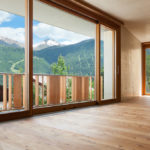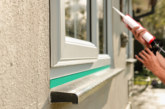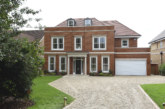 Tony Pell, Chairman of the Wood Window Alliance (WWA), explains how the specification of wooden materials can help to bring the outside space inside the home.
Tony Pell, Chairman of the Wood Window Alliance (WWA), explains how the specification of wooden materials can help to bring the outside space inside the home.
Wood has been the natural choice for windows and doors for centuries. However, over the last few decades, many housebuilders have chosen to install PVC-U windows over wood windows as it was perceived that they provide a longer life.
Having worked in the timber industry for 20 years, I’ve witnessed significant advancements in technology and manufacturing which has driven the use of timber across a variety of projects, from social housing to healthcare and education. The world’s oldest and most traditional building material is being increasingly revaluated as a modern-day first choice.
Solid credentials
The use and popularity of timber has grown over the last few years for a myriad of reasons. First of all, wood is intrinsically beautiful, embodies character and consumers understandably love it. Additionally wood is proving to be the catalyst for architecture and construction professionals in creating spaces that promote lower carbon emissions and provide a real connection to nature.
Wood windows also provide longevity. Independent research by Heriot Watt University looked at a typical wooden window made to WWA standards and found that the window had an expected service life of 60 years.
With advancements in technology and the use of engineered softwood and quality hardwood, the manufacture of wood windows and doors has dramatically changed over the past two decades. Factory finished products are produced in humidity-controlled environments and are given a specialist micro-porous paint or stain finish. When made to WWA standards, factory-finished windows are backed with a supplier-backed coating guarantee – typically 10 years for paint and seven years for stain coatings, dependent on exposure.
Aversion to plastics
Finally, there is a growing appetite amongst homeowners for natural materials – they don’t want their houses to contribute to global warming and would much rather see their home built with timber sourced from sustainable forests, where more trees get planted than chopped down.
Wood windows made to WWA standard have negative Global Warming Potential over their estimated 60 year life service, with each frame saving 160kg CO2 over its estimated lifecycle compared to a PVC-U equivalent. Additionally all WWA members hold either FSC or PEFC chain of custody certification to show how they source timber from sustainably managed forests.
Sense of wellbeing
Furthermore, on a more emotional and subjective level, research suggests that consumers want their homes made from natural materials because is a proven enhancer of wellbeing. In a Japanese study, exposure to wooden panels was found to significantly decrease blood pressure. Two years ago the WWA undertook independent research with 1,000 homeowners across the UK which revealed that 49% of homeowners feel that having natural materials in their homes makes them feel happier.
Oliver Heath, an expert in Biophilic Design (which is based on Biophilia, the inherent human inclination to affiliate with nature) comments: “Our homes have become significantly less healthy over the last 20 years due to a build-up of chemicals in materials, fixtures and fittings but also as they have become increasingly sealed up. The more we can introduce natural materials, the less we are likely to be inviting in toxins. If we use materials like solid wood with natural or water-based finishes, we can do a lot to reduce toxins in the home.
“Our homes are absolutely critical to our mental and physical wellbeing. They are the backdrops to our lives; we spend two thirds of our lives at home and 90% of our lives indoors. So, the spaces that we surround ourselves with inevitably have an important impact on the way that we feel… not just our physical wellbeing but also our mental wellbeing, as well as our ability to improve our cognitive focus.”
Changing times
In light of this, it seems incongruous for housebuilders to use plastic. Britain is moving into a post-plastic age and in WWA independent research timber is cited by 67% per cent of homeowners as the material they would like to have more of in the home. British homeowners perceive timber windows as the most environmentally friendly (44%), most aesthetically pleasing (44%), the nicest to live with (33%) and providing the most character (56%).
The desire to live a life surrounded by natural materials is growing and most Brits want to lead a more sustainable life. The great news is that if housebuilders incorporate wood, they will be rewarded both in terms of popularity with consumers, but also performance and environmental credentials.



